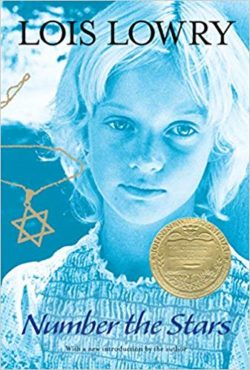 by Lois Lowry
by Lois Lowry
Conditional Recommendation: In German-occupied Denmark, ten-year-old Annemarie learns what it means to be brave as she helps her best friend Ellen escape from the Nazis.
Awards: Newbery Medal (1990), National Jewish Book Award for Children’s Literature (1990), Sydney Taylor Book Award for Older Readers (1989), Jane Addams Children’s Book Award Nominee (1990), Charlotte Award (1992), Dorothy Canfield Fisher Children’s Book Award (1991), Charlie May Simon Children’s Book Award (1992), Rebecca Caudill Young Readers’ Book Award (1992)
My chest tightened with emotion as I read Number the Stars in suspense. By the end, I cried. This moving, historically accurate story of the effort to evacuate Jews from Nazi-occupied Denmark should not be missed. Though the circumstances are sad, I was encouraged by reading of a group of people persevering in dangerous conditions to save another group of people targeted by the Nazis. The heroism enlarges your heart.
Scroll down for a video for historical context.
“How brave are you, little Annemarie? Uncle Henrik asks his ten-year-old niece. It is 1943, and to Annemarie Johansen, life in Copenhagen is a complicated mix of ordinary home and school life, food shortages, and the constant presence of Nazi soldiers. Bravery seems a vague virtue—one possessed by dragon-slaying knights in the bedtime stories she tells her younger sister, Kirsti. Too soon, she herself is called upon for courage.
As the German troops begin their campaign to “relocate” all the Jews of Denmark, the Johansens take in Annemarie’s best friend, Ellen Rosen, and pretend she is part of the family. Ellen and Annemarie must think quickly when three Nazi officers arrive late one night and question why Ellen is not blond, like her sisters. Through Annemarie’s eyes, we see the Danish Resistance as they manage to smuggle almost the entire Jewish population, nearly 7,000 people, across the sea to Sweden. In this tale of an entire nation’s heroism, Lois Lowry reminds us that there is pride and human decency in the world even during a time of terror and war.
Value of Human Life – The publisher called it “human decency” when it’s really believing that every human has innate worth and acting on that belief. The efforts the Danish people undertook to save the persecuted Jews confirm it. Human decency is valuing human life and taking a stand against those who say otherwise.
Courage/Bravery – Early on, Annemarie isn’t sure that she has what it takes to protect her Jewish best friend and their family. “Annemarie admitted to herself, snuggling there in the quiet dark, that she was glad to be an ordinary person who would never be called upon for courage” (pg. 26). However, the story shows us that ordinary people are often called to be courageous, especially against the backdrop of war and systematic prejudice. Annemarie bravely does what’s needed to be done despite danger and, as her Uncle Henrik explains, sometimes that’s all courage is.
Annemarie doesn’t understand what the Nazis are doing or why they target Jews—she just knows they are. The true horrors of the Holocaust are left out of this book, but the reader still understands, as Annemarie does, that the Nazis are dangerous and it’s a great risk to be noticed by them, much less oppose them in any way. This book sets the scene of that time in history really well—in a way that’s easy for a young reader to understand and without overwhelming detail. This would be a good book to use to introduce young readers to the Jewish plight during WWII. The characters are fictional but many things in the book are historically accurate and based on recorded historical events. At the back of the book, Lowry explains “where fact ends and fiction begins” in her novel. Don’t forget to read that once you finish the book; it lends more meaning to the story.
When the Germans occupied Austria, life for the Jews changed in a single day. When the Germans occupied Denmark, they didn’t target or “relocate” the Jews right away, instead dwelling there for years before acting. The plot matches this pace by beginning slow, then increasing the pace, sense of danger, and suspense steadily to the end. So if your reader doesn’t get hooked immediately, wait it out and keep reading. Soon you’ll be engrossed and unable to put the book down!
I think any book about WWII and the Holocaust will leave an impression. This book impresses you with the seriousness of the times and the danger of being discovered by the Nazis, but it also impresses on the reader the value of courage, friendship, and doing what’s right even when frightened.
Many books on this topic, even being fiction, are dark and depressing—those were dark and depressing times—but this one contains a sense of victory and ends with hope.
This book isn’t graphic and is wholly appropriate for young readers but I thought I’d mention a few things in case you have a sensitive reader. Annemarie’s older sister, Lise, is dead and it isn’t until the war is over years later that she learns her sister was part of the Danish Resistance and was run down by a Nazi car after fleeing a secret meeting. Annemarie has some confrontations with Nazi soldiers that might be scary for sensitive young readers—they’re certainly suspenseful for older readers. But nothing bad happens to Annemarie! At the end of the book, which skips years ahead to the end of the war, Annemarie tells readers that a character died during the war. He was executed by shooting in a public place and his body wasn’t returned, but buried where it fell.
More further context of Denmark during WWII check out this video:
*This post may contain affiliate link(s). See full disclosure on legal page.
